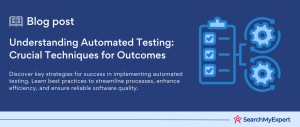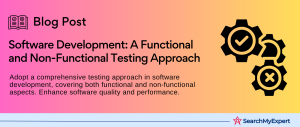Understanding Software Testing: Its Importance and Types
In the fast-paced world of technology, where software applications drive the critical aspects of business operations and everyday life, ensuring these applications run flawlessly is paramount. Software testing stands at the heart of this endeavor, serving as a cornerstone in the development process. This article dives into the essence of software testing, its significance, the benefits it brings to the table, and the various methodologies employed by professionals to guarantee software reliability and performance.
What is Software Testing?
At its core, software testing is a systematic activity designed to evaluate the functionality, security, and overall performance of a software application against specified requirements. It is the process of identifying any errors, gaps, or missing requirements contrary to the actual desires. By meticulously analyzing every aspect of the software, testers aim to ensure that the final product is free of defects, meets the end users’ needs, and performs as intended in various environments.
Why is Software Testing Important?
The importance of software testing cannot be overstated. In an era where digital solutions are integral to business strategies and consumer products, a minor glitch can lead to significant financial losses, tarnish brand reputations, and even pose serious safety risks. Software testing is crucial because it:
- Ensures Quality:
Testing helps in maintaining a high quality of the software, ensuring that it is reliable, secure, and user-friendly. - Reduces Costs: Early detection of defects can significantly reduce the cost of fixing bugs, as issues identified later in the development cycle can be more expensive to resolve.
- Enhances Security: With cyber threats on the rise, testing is vital in identifying vulnerabilities and safeguarding the software from potential attacks.
- Improves User Experience:
By ensuring the software runs smoothly and efficiently, testing enhances the overall user experience, leading to higher satisfaction and loyalty.
Benefits of Software Testing
The benefits of software testing extend beyond just bug detection. It plays a pivotal role in:
- Boosting Confidence:
Stakeholders gain confidence in the software’s quality and reliability, which is crucial for its adoption and success. - Facilitating Regulatory Compliance: Many industries require software to comply with specific standards. Testing ensures compliance, avoiding legal penalties and fines.
- Supporting Product Optimization:
Testing provides insights into software performance and user experience, offering opportunities for improvement and optimization.
Different Types of Software Testing
Software testing encompasses a wide array of types, each designed to uncover specific kinds of issues or to evaluate particular aspects of the software. The most common types include:
- Functional Testing:
Focuses on the functional requirements of the software, ensuring that each feature works as expected. - Non-Functional Testing: Evaluates the performance, usability, reliability, and security of the software, rather than its specific behaviors.
- Manual Testing:
Involves human testers to execute test cases without the use of automation tools, offering the flexibility to adapt and explore. - Automated Testing:
Utilizes software tools to run predefined test cases on the application automatically, enhancing efficiency and coverage. - Integration Testing: Checks the interfaces and interaction between different modules or components of the software.
- System Testing:
A comprehensive testing of the entire software system to verify that it meets the specified requirements and functions correctly in its intended environment. - Acceptance Testing:
The final phase of testing before the software is released to the market or handed over to the client, ensuring it meets their expectations and requirements.
Navigating the Software Development Lifecycle (SDLC) and the Role of Testing
The Software Development Lifecycle (SDLC) is a structured process that outlines the steps involved in the development of software applications. It provides a systematic approach to building software that meets quality standards and user expectations. Understanding the SDLC phases and the integral role of software testing within this framework is crucial for successful project execution. This section explores the different phases of the SDLC, where software testing fits into this lifecycle, and its impact on other SDLC phases.
Different Phases of SDLC
The SDLC is typically divided into several distinct phases, each with specific objectives and deliverables. While models may vary, the core phases often include:
- Requirement Analysis: This initial phase involves gathering and analyzing the requirements from stakeholders to define the software’s scope and objectives clearly.
- Design: Based on the requirements, the system and software design documents are prepared, outlining the architecture and defining overall system architecture.
- Implementation (or Coding): During this phase, the actual coding of the software takes place, where developers write the code according to the previously defined design specifications.
- Testing:
After the software is developed, it undergoes rigorous testing to identify and fix any defects or issues, ensuring that the software meets the required standards and behaves as expected. - Deployment:
Once the software is tested and ready, it is deployed in the production environment for actual use. - Maintenance: Post-deployment, the software is maintained for its operational life, involving updates, modifications, and patches to ensure it continues to meet user needs.
Where Does Software Testing Fit in the SDLC?
Software testing is traditionally seen as a phase that comes after the implementation or coding phase. However, in modern agile methodologies, testing is integrated throughout the SDLC. This approach, known as continuous testing, allows for early detection of issues and alignment with user requirements from the outset. Testing during the early stages of the SDLC not only reduces the cost and effort required to fix issues but also ensures a better understanding of the project scope and requirements among the development and testing teams.
How Does Software Testing Impact Other SDLC Phases?
Software testing significantly impacts various phases of the SDLC, including:
- Requirement Analysis:
Testing provides feedback on the clarity and testability of requirements, leading to more precise and detailed requirement documentation. - Design:
Testers can offer insights into potential design issues and improvements, ensuring the design is robust and conducive to a stable and efficient system. - Implementation:
Continuous testing during this phase helps developers identify and fix issues early, improving code quality and reducing the time to market. - Deployment: Thorough testing ensures that the software is ready for deployment, minimizing the risks of post-launch issues and ensuring a smoother transition to the production environment.
- Maintenance:
Testing plays a crucial role in the maintenance phase by identifying bugs and issues in existing features, ensuring the software continues to meet user needs and compliance requirements.
Mastering Testing Fundamentals: Principles, Techniques, and Tools
Delving into the world of software testing reveals a complex ecosystem of principles, techniques, and tools designed to ensure the delivery of high-quality software products. Mastering these fundamentals is crucial for testers and developers alike, as it equips them with the knowledge to identify defects, design effective test cases, manage the defect lifecycle, and utilize the right tools for efficient testing. This section explores the foundational aspects of testing, offering insights into its principles, test case design, defect management process, and the variety of tools and techniques available.
Basic Testing Principles
Several core principles underpin the practice of software testing, guiding testers in their approach to identifying and resolving issues. These include:
- Testing Shows the Presence of Defects: Testing can reveal defects but cannot prove that there are no defects. It reduces the likelihood of undiscovered issues.
- Exhaustive Testing is Impossible: Given the vast number of inputs and test paths, it’s impractical to test everything. Focus is on the most critical and likely areas for defects.
- Early Testing: Integrating testing early in the software development lifecycle helps in identifying and fixing issues sooner, which can significantly reduce costs and time.
- Defect Clustering: Defects tend to be clustered in specific areas (Pareto principle). Identifying these areas can optimize testing efforts and resources.
- Pesticide Paradox:
Repeatedly using the same test cases can lead to diminishing returns as they become ineffective in finding new defects. Regularly updating test cases is essential. - Testing is Context-Dependent:
The approach to testing varies depending on the context, such as the type of software and its application domain. - Absence-of-Error Fallacy:
A software product without known defects is not necessarily ready for use; it must also meet user needs and fulfill its intended purpose.
Test Case Design Techniques
Effective test case design is critical for uncovering defects and ensuring the software behaves as expected. Test case design techniques include:
- Black Box Testing:
Focuses on the functionality of the software without considering its internal workings. Techniques include equivalence partitioning, boundary value analysis, and decision table testing. - White Box Testing: Involves testing the internal structures or workings of an application, often used for unit testing. Techniques include statement coverage, branch coverage, and path coverage.
- Experience-Based Testing: Relies on the tester’s experience, knowledge, and intuition to design test cases, often used when there are no clear specifications.
Defect Management Process
Defect management is a critical component of the testing process, involving the identification, documentation, and resolution of defects. The process typically includes:
- Detection:
Identifying a defect during testing. - Documentation:
Recording the defect in a defect tracking system with details such as severity, steps to reproduce, and expected vs. actual results. - Prioritization:
Assessing the defect’s impact and urgency to determine its priority for resolution. - Assignment:
Assigning the defect to the relevant team member for fixing. - Resolution: The assigned developer addresses the defect, modifying the code as needed.
- Verification:
Testers verify the fix to ensure the defect has been resolved. - Closure:
Once verified, the defect is marked as closed in the tracking system.
Testing Tools and Techniques
A wide range of tools and techniques supports the testing process, enhancing efficiency and effectiveness:
- Automated Testing Tools:
Tools like Selenium, QTP, and TestComplete automate the execution of test cases, increasing speed and accuracy. - Performance Testing Tools: Tools such as LoadRunner and JMeter help test the application’s performance under load.
- Security Testing Tools:
Tools like OWASP ZAP and Nessus assist in identifying vulnerabilities in the software. - Test Management Tools: Applications like JIRA, TestRail, and Quality Center support test planning, execution, and defect tracking, facilitating collaboration among testing teams.
Exploring the Types of Software Testing: A Comprehensive Guide
Software testing is a multifaceted field with various testing types, each addressing different aspects of software quality. These types can be broadly categorized into functional vs. non-functional testing, white-box vs. black-box testing, and manual vs. automated testing. Additionally, specific testing methodologies like unit testing, integration testing, system testing, and acceptance testing play pivotal roles at different stages of the software development lifecycle. This guide delves into these categories, offering insights into their purposes, methodologies, and when they are most effectively employed.
Functional Testing vs. Non-Functional Testing
Functional Testing
Functional testing focuses on the software’s specific actions or functions, ensuring it behaves as expected according to the requirements. It verifies that each software function operates in conformance with the requirement specification. Key types include:
- Unit Testing:
Tests individual components or units of code for correctness. - Integration Testing: Ensures that integrated components or systems work together as intended.
- System Testing: Validates the complete and fully integrated software product.
- User Acceptance Testing (UAT):
Confirms that the software meets business needs and users can accept it.
Non-Functional Testing
Non-functional testing evaluates the software’s operational aspects, such as performance, usability, reliability, and security, which are not related to specific functional behaviors. Types include:
- Performance Testing:
Assesses the software’s speed, responsiveness, and stability under a particular workload. - Usability Testing: Ensures that the software is user-friendly and intuitive.
- Security Testing:
Identifies vulnerabilities, threats, and risks in the software. - Compatibility Testing:
Checks the software’s compatibility with different environments, browsers, databases, etc.
White-Box Testing vs. Black-Box Testing
White-Box Testing
White-box testing, also known as clear or glass box testing, involves testing internal structures or workings of an application, as opposed to its functionality. Testers have knowledge of the internal paths, structures, and implementation of the software being tested. It is commonly used in unit testing, integration testing, and certain types of system testing.
Black-Box Testing
Black-box testing focuses on the software system’s external behavior rather than its internal structure. Testers do not have access to the internal code and test the software by providing inputs and examining outputs. This approach is prevalent in functional testing, such as system testing and user acceptance testing.
Manual Testing vs. Automated Testing
Manual Testing
Manual testing involves human testers performing tests manually without the aid of automated tools. Testers follow a set of designed test cases to validate the functionality, usability, and overall behavior of the software application. It is flexible and allows for exploratory testing, making it suitable for usability and ad-hoc testing.
Automated Testing
Automated testing uses software tools to execute pre-scripted tests on the software application automatically. It is efficient for running repetitive tasks and regression tests, providing fast feedback to the development team. Tools like Selenium, QTP (QuickTest Professional), and frameworks designed for specific programming languages or applications facilitate automated testing.
Elevating Software Quality through Effective Test Case Design
Test case design is a critical aspect of the software testing process, laying the groundwork for identifying defects and ensuring the software meets its intended specifications. This phase involves creating a set of conditions or variables under which a tester will determine whether an application or software system is working correctly. The importance of test case design cannot be overstated, as it directly influences the efficiency, coverage, and success of the testing efforts. This section delves into the significance of test case design, explores various techniques, and provides guidance on writing and maintaining effective test cases.
Importance of Test Case Design
Effective test case design is essential for several reasons:
- Ensures Comprehensive Testing: Well-designed test cases cover both functional and non-functional aspects of the software, ensuring a thorough evaluation.
- Facilitates Automated Testing:
Clearly defined test cases are crucial for automating testing processes, enhancing efficiency and consistency. - Improves Defect Detection:
Strategic test case design can help uncover hidden defects, reducing the risk of post-release issues. - Supports Test Maintenance:
Organized and well-documented test cases simplify the process of updating tests as the software evolves.
Different Test Case Design Techniques
Test case design techniques can be broadly categorized into three main types: black-box, white-box, and experience-based techniques. Each has its approach and is chosen based on the testing requirements and the phase of the SDLC.
Black-Box Techniques
- Equivalence Partitioning:
Divides input data of a software unit into partitioned groups that are expected to exhibit similar behavior. - Boundary Value Analysis: Focuses on the values at the boundaries of input domains, including minimum, maximum, just inside, and just outside boundaries.
- Decision Table Testing:
Uses a table to represent combinations of inputs and the corresponding outputs, making it easier to visualize complex business logic.
White-Box Techniques
- Statement Coverage: Ensures every statement in the code has been executed at least once.
- Branch Coverage:
Tests every possible branch (if-else conditions) from each decision point in the code. - Path Coverage:
Involves testing all possible paths (sequences of events) through a given part of the code.
Writing Effective Test Cases
Writing effective test cases is an art that requires precision, clarity, and a deep understanding of the software being tested. Here are some key considerations:
- Clear and Concise: Test cases should be straightforward and understandable, with unambiguous steps and expected outcomes.
- Reproducible:
Steps should be detailed enough to allow any tester to reproduce the test. - Independent:
Each test case should be self-contained and not depend on the outcome of another. - Traceable:
Link test cases to their corresponding requirements or user stories to ensure coverage.
Maintaining and Reviewing Test Cases
Regular maintenance and review of test cases are vital to keep them relevant and effective:
- Periodic Reviews:
Regularly review test cases for accuracy, relevance, and completeness, especially after changes in the software. - Update Test Cases:
Modify test cases to reflect changes in the application or requirements, ensuring they remain effective for future testing cycles. - Remove Obsolete Tests:
Eliminate test cases that are no longer applicable to the software to maintain a lean and efficient test suite.
Test Execution and Reporting: Ensuring Software Quality through Diligence
Test execution and reporting are crucial phases in the software testing lifecycle, where the planned test cases are put into action, defects are meticulously logged and tracked, and the outcomes are analyzed and communicated to the relevant stakeholders. This stage is where the theoretical aspects of testing converge with practical application, revealing the software’s actual quality and readiness for release. Efficient execution, comprehensive defect management, and clear reporting are essential for a successful testing process. This section explores the intricacies of executing test cases, logging and tracking defects, and the best practices for test reporting and communication.
Executing Test Cases
Executing test cases involves running the tests designed during the test case design phase against the software application to identify any defects that deviate from the specified requirements. Key considerations for effective test execution include:
- Preparation:
Ensure the testing environment is set up correctly and all necessary resources are available. - Prioritization: Execute test cases based on their priority, focusing first on critical functionalities and high-risk areas.
- Documentation:
Record the outcomes of each test case, including pass/fail status and any deviations from expected results.
Defect Logging and Tracking
When defects are identified during test execution, they must be logged and tracked through a systematic process:
- Defect Logging:
Record defects in a defect tracking tool with detailed information, including steps to reproduce, severity, priority, and expected versus actual results. - Defect Tracking: Monitor the status of logged defects as they progress through various stages, such as new, assigned, fixed, retested, and closed.
- Collaboration: Facilitate communication between testers and developers to ensure a clear understanding of the defect and the steps needed for resolution.
Test Reporting and Analysis
Test reporting and analysis involve synthesizing the data collected during test execution into actionable insights:
- Test Summary Reports: Create comprehensive reports summarizing the testing efforts, including the number of test cases executed, passed, failed, and the defects found.
- Quality Analysis:
Analyze the defects in terms of severity, impact, and root causes to identify patterns and areas requiring improvement. - Metrics and KPIs: Utilize key performance indicators (KPIs) and metrics, such as defect density, test coverage, and pass/fail rates, to measure the effectiveness of the testing process.
Communicating Test Results
Effective communication of test results to stakeholders is critical for informed decision-making:
- Clarity and Transparency:
Present the test results clearly, highlighting the key findings and their implications for the software’s quality and release readiness. - Actionable Recommendations: Provide recommendations based on the test results, suggesting areas for improvement, additional testing needs, or readiness for release.
- Stakeholder Engagement: Engage with stakeholders throughout the testing process to ensure alignment and address any concerns or questions regarding test outcomes.
Embracing the Future of Software Testing
As we navigate through the intricacies of software testing, from its fundamental principles to the execution and reporting stages, the significance of continuous testing emerges as a pivotal theme. This approach not only enhances software quality but also aligns testing practices with the dynamic and agile nature of modern software development. The future of software testing promises further advancements, driven by technological innovations and evolving methodologies. This concluding section underscores the importance of continuous testing, explores the future landscape of software testing, and suggests resources for further learning.
Importance of Continuous Testing
Continuous testing integrates testing activities into every phase of the software development lifecycle, providing immediate feedback on the business risks associated with a software release candidate. This approach offers several benefits:
- Rapid Feedback:
Continuous testing enables early detection of defects, reducing the cost and effort required for their resolution. - Higher Quality:
By testing early and often, software quality is improved, enhancing user satisfaction and trust. - Increased Agility:
Teams can quickly respond to changes in requirements or market conditions, ensuring the software remains relevant and competitive.
The Future of Software Testing
The future of software testing is shaped by emerging trends and technologies that promise to revolutionize how we approach quality assurance:
- Artificial Intelligence and Machine Learning:
AI and ML are set to automate complex test case generation, analysis, and optimization processes, making testing more efficient and intelligent. - DevOps Integration:
Closer integration with DevOps practices will continue, emphasizing continuous testing throughout the development pipeline to enhance speed and efficiency. - Shift-Left and Shift-Right Testing: These approaches advocate for testing earlier (shift-left) and in production (shift-right) to ensure comprehensive coverage and real-world validation.
- Increased Focus on Security Testing:
As cyber threats evolve, security testing will become an integral part of the testing strategy, focusing on vulnerability assessments and risk management.
Resources for Further Learning
For those keen on diving deeper into software testing and staying updated with the latest trends, the following resources can be invaluable:
- Online Courses: Platforms like Coursera, Udemy, and edX offer courses on software testing fundamentals, automation, and specialized areas like performance and security testing.
- Professional Communities: Joining communities such as the Association for Software Testing (AST) or attending conferences can provide insights into industry best practices and networking opportunities.
- Books and Publications:
Books like “Lessons Learned in Software Testing” by Cem Kaner, James Bach, and Bret Pettichord, and publications from the IEEE and ACM on software testing and quality assurance offer in-depth knowledge.
Conclusion:
The domain of software testing is a critical facet of the software development lifecycle, ensuring the delivery of reliable, secure, and high-quality software products. Through a detailed exploration of testing principles, methodologies, and best practices, we’ve uncovered the significant impact of continuous testing and the evolving nature of this field. As we venture into the future, the integration of advanced technologies like AI and ML, along with a deeper alignment with DevOps and agile practices, promises to further enhance the efficiency and effectiveness of testing processes.
Redefine your approach to software quality with Software Testing Service Firms.
Table of Contents
Toggle






